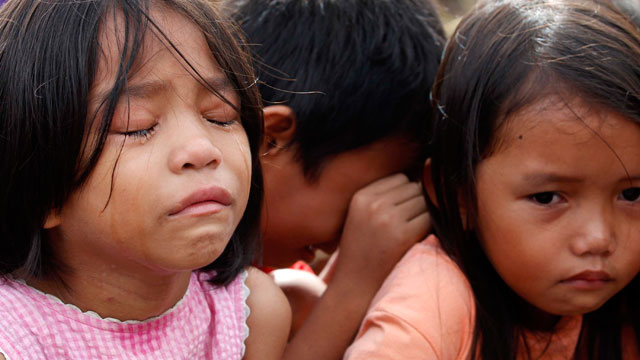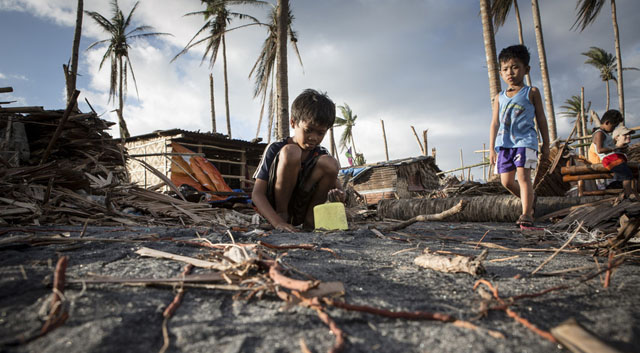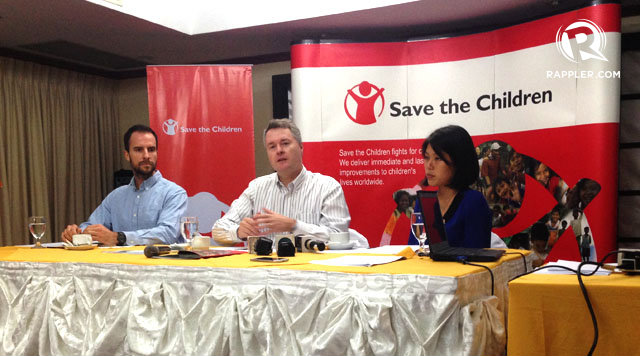SUMMARY
This is AI generated summarization, which may have errors. For context, always refer to the full article.

MANILA, Philippines – “If there is one thing we have learned during these past decades, it is that children are the most vulnerable. Children are the most at risk, and frequently and commonly pay the highest price during crises.”
Save the Children operations team leader Ned Olney stressed the needs of child survivors in the aftermath of Super Typhoon Yolanda (Haiyan) at a press briefing on relief efforts on Friday, November 22. (READ: Breastfeeding ‘critical’ to baby’s survival in calamity areas)
The international aid organization aims to help 500,000 people in the coming weeks and months, especially children. So far, it has been able to reach out to over 9,000 children across affected areas in Leyte (including Tacloban City) and Panay Island. It has also established field bases in Ormoc, Roxas and Estancia, and a logistics support team in Cebu.
“What the Philippines is facing is really one of the worst humanitarian crises that I have experienced. The scale is really staggering,” Olney said. Citing United Nations Office for the Coordination of Humanitarian Affairs (UNOCHA) estimates, the organization said that the typhoon has affected around 5.4 million children.
Responding to post-disaster needs, Save the Children has delivered hygiene kits and shelter kits for families in Tacloban City, Leyte. One of its mobile teams was also the first group to provide medical services in Dulag, also in Leyte. Medical teams for treating the injured and wounded have also reached communities in the northern tip of Cebu and the northeastern islands of Panay.
Some of these areas, especially those in Panay, are still getting little media and international attention, Olney said. “I think what we’re going to see is an expansion of the humanitarian coverage from Tacloban, from Roxas, from a few major urban areas – and out into the rural areas.”
Save the Children has already launched an emergency appeal of US$50 million to fund relief efforts. The organization plans to expand operations and to add more relief programs, including sending out breastfeeding counselors to guide mothers in feeding their babies.
Child-friendly spaces and aid supplies
Setting up child-friendly spaces in Tacloban has been one of the immediate lifesaving interventions of the organization. These function like day-care centers, providing distraction and play spaces for children while keeping them safe.
Children play games and share their experiences of the typhoon with each other as part of their recovery. With trained adults, they also get to read as a form of informal education incorporated in these spaces. (READ: Yolanda damaged 3,171 schools – DepEd)
These can be helpful to parents who need to keep their children safe while they look for lost loved ones or food and water. The organization plans to set up hundreds of these centers across affected areas.
“Children must always be protected before, during and after emergencies. If you do not put into play systems that protect children very early on, as we know from crises around the world…the cases of abuse, exploitation and trafficking go up,” Olney said.

Situation on the ground
Helping the young in the aftermath poses an enormous challenge, as suggested by on-the-ground observations. Children in affected areas have lost families and homes, and are exposed to unsafe surroundings that lack sources of food and water.
Communications manager Lynette Lim, who had been in Palo (south of Tacloban City) during the storm, said that at evacuation centers, children were loitering around with no routine because schools have been shut. “Children also have no safe spaces to play. In fact, families have told us that their children are getting sick from playing in unsanitary conditions,” she said.
She also observed that some children were in distress. Families reported lack of food and water for their children, and a lack of sanitation facilities and water supply. Clinics outside of Tacloban have reported a lack of capacity to treat anything beyond simple cuts. Other injuries needed hospital care, but for many families, access and transportation to hospitals within the city itself was already an issue. (READ: Children in Yolanda-hit areas to receive free vaccines)
“Parents have also reported that they have no jobs, and so will be unlikely able to feed their children in the long-term as well as to rebuild their homes,” Lim added.
Challenges during initial response
Save the Children’s relief operations had already begun at the early onset of the disaster and had been able to provide initial support to families. But it has also faced obstacles along the way.
“Many of the crises we’ve seen, whether it’s an earthquake or a typhoon – they’re isolated and in specific locations. So here, you’ve got hundreds of kilometers in multiple islands, that’s one. Two, airports cut off. Roads cluttered with debris,” Olney said, enumerating the challenges of aid delivery.
“We had to set up a logistical hub in Cebu. We had cargo planes come to Cebu. How do we move that support to Tacloban? Ferry to Ormoc, ferry all the way to Tacloban. We ran out of diesel, and we had to bring a barge of diesel from Mindanao.”
Staff had to be deployed to Ormoc via ferries, then they were brought to the target areas via motorcycles.
Even relief workers themselves had to ration their food and water.
“Let me tell you – our team that was on the ground the first week. They were eating essentially ramen noodles with just not even hot water – just room temperature water. They just allowed the noodles to soak. It was the only thing they had to eat. There was nothing else,” Olney said.
“We empathize with the local community. There simply wasn’t enough food or water. And one day we had a team of 10 people and they were sharing one liter of water. There was no water available.”
The Save the Children relief team has been working 24 hours a day, in coordination with the humanitarian response team under UN OCHA, and with local government agencies and municipal governments, according to Olney. With full teams on the ground, the organization expects to be able to reach out to more people in the coming days. – Karen Liao/Rappler.com
Add a comment
How does this make you feel?

There are no comments yet. Add your comment to start the conversation.